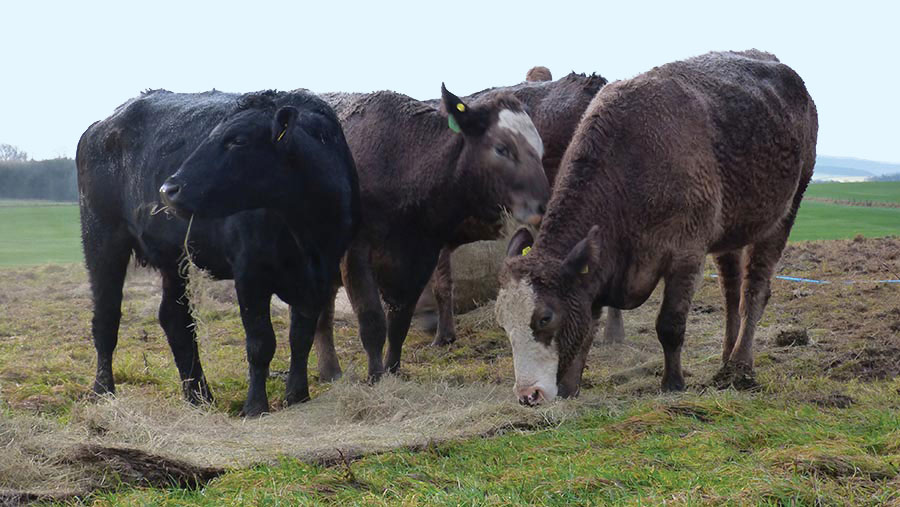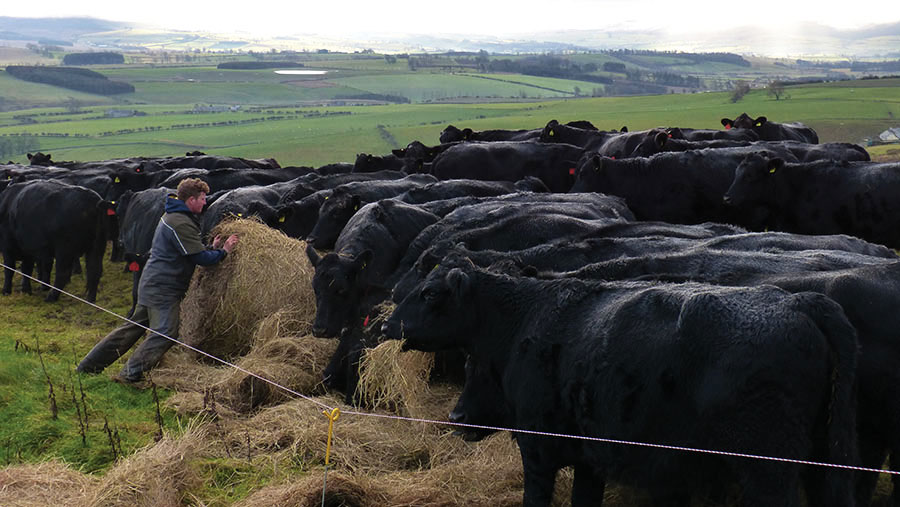Video: Outwintering system hopes to beat £163 a cow savings
 Mature cows outwintered on deferred hill grazing © MAG/Michael Priestley
Mature cows outwintered on deferred hill grazing © MAG/Michael Priestley Trial and error are paying off for a Northumberland mixed farm that has transitioned to outwintering its suckler herd over the past three winters.
The Sordy family and the team at Alnham Farm, near Alnwick, aims to save close to £200 a cow this winter (see “Cost savings: Alnham Farm” below) compared to their old housed system.
Previously, cows were housed in November on a silage/straw/pot ale syrup ration, fed through a tub mixer and bedded on straw courts from straw from the arable unit.
Cows would typically be turned out in April with a calf at-foot.
See also: How outwintering cut suckler farm costs to 243p/kg
Farm facts
- 225 suckler cows
- 1,216ha of mostly grassy hill up to 518m above sea level
- 20ha of arable, growing winter wheat
- 2,600 ewes, including 250 ewe lambs put to the tup
- 121ha of improved ground, growing herbal leys and ryegrass
- Cattle go deadweight to Linden Foods
- AHDB Monitor Farm
Hear more from The Sordy family as they explain the changes they have made to their system during the last three winters and how those have resulted in cost savings in the video below.
Structural change
To make the switch to outwintering work, the farm has been restructured. Notice was given on an outlying rented farm of 240ha (593 acres) in 2021 and the ewe flock was dropped by 500 head.
Two areas of hill were fenced in half. The better in-bye land was divided in two using Clipex fencing (£1.50/m in materials) to allow grass more recovery time.
Ewes were tupped as lambs to make up for the drop in flock size. This meant ewes could come off the hill in June (three or four months earlier) so grass could be deferred for the wintering cows.
Use of a Charolais terminal sire, criss-crossing with Simmental and Angus, has been replaced by a team of five Angus sires, and two Simmentals (being phased out).
A group of 30 nine-month-old Luing heifers was bought locally to winter on the hill.
By moving to outwintering and rotational grazing, silage acreage has fallen 50% and most good in-bye ground has been sewn with herbal leys. The arable acreage has reduced 80%.
Advice from AHDB and farm consultants Rhidian Jones of 5 Agri and Emily Grant of Forrit Consultancy, through AHDB’s Monitor Farm scheme, have helped the team make alterations, says Harry Sordy.
Hill potential
The least productive part of the farm – the grassy hill – is nevertheless hugely valuable because it provides low-cost wintering ground.
The Sordys hope to have a lower winter feed cost this year by keeping more cows on the hill for longer.
One hill has been split with 1.1km of permanent fencing, 600m of four-wire semi-permanent fencing and 1.2km of polywire.
More semi-permanent four-wire fencing may follow in future (with grant funding) to further subdivide it, helping ration better bits of ground and keeping cattle out of wet corners.
Cost savings: Alnham Farm
Historic winter: 20 weeks at £18.20/week = £364
Winter 2022-23 for the typical cow
- Deferred hill: Six weeks (eight-week target this year) at £1.50 = £9
- Deferred in-bye grass and bales: Six weeks (eight-week target this year) at £7.50 = £45
- Housed period: Eight weeks (four-week target this year) at £18.20 = £145.60
- Total average cost last year = £199.60
- Saving = £164 (Possible saving of £219 a cow if targets are met this winter)
Costs
Costs are calculated with the help of Rhidian Jones, of RJ Livestock Systems, to include all cash costs (including fuel and labour), feed, machinery, and depreciation (Harry Sordy and a full-time cattle staff member draw a wage from the enterprise).
The hills are covered in bog and watercourses, providing water. However, summer 2022 was drier, so a solar pump was used to supply a drag trough.
The Sordys are fortunate to have a variety of good in-bye ground, marginal updland and hill ground, giving them several outwintering options.
The four options are as follows:
Deferred hill – no bales
Place in the system
Two batches of 60 cows strip graze two pieces of hill about 34ha in size with temporary fencing. Grass is deferred from the start of June.
The fittest mature cows are sent to the hill and must be body condition score (BCS) 3 and above as they aren’t supplemented.
This should hopefully feed cows for two months from mid-November to mid-January. An emergency piece of in-bye ground with 20 hay bales adjacent.
Lessons learned
- People and machines are responsible for more “poaching and mess” than cattle
- Watching rumen fill is vital to ensure cows have enough hill to graze
- Graze the rougher, less-sheltered parts of the hill early on when cows are in good condition or in kinder weather.
Deferred grass on older leys and hay
Place in the system
360 hay bales (netted, not wrapped) have been allocated on deferred grass. Cows are budgeted to get 50% of their dry matter requirement from hay.
This is used as a buffer if the hill becomes too challenging in the winter. Some years it may be necessary to flip the cows between hill grazing and bale grazing as conditions change.
Lessons learned
- Back fencing can be important to get them to graze standing grass
- Incrementally moving to outwintering was a good decision (over three winters). In the first winter, the farm tried it on the fittest 80 cows, which was doubled last year. Just three of the leanest cows were housed from the start of this winter
- Deferring grass on old pastures with more thatch, stronger swards and deeper roots helps hold cattle up.

Harry Sordy outwintering cattle on a bale pod © MAG/Michael Priestley
Westerwolds and herbal ley haylage
Place in the system
A group of 43 Leaner cows and 47 in-calf heifers are on good ground drilled with Westerwolds and Italian ryegrass after arable nearer the steading, so they can be housed if necessary.
For example, if there was 40 days of grazing left, housing the heifers would double the days left for half the remaining older cows to 80 days. Reseeding with herbal leys after ploughing and power harrowing will address any compaction/poaching.
Lessons learned
- Poaching is more of an issue than on permanent pasture
- High-quality forage can lead to heifers becoming fat (some were 3-3.5 BCS to start with), which is why other options are important. Housing and feeding a more straw-based diet to prevent slow calvings and caesareans is one option
- Higher dry matter haylage/silage maintains intakes in wet weather.
Housing on straw courts and chopped forage
Place in the system
The tub mixer remains (mainly for youngstock) to feed a chopped straw and haylage diet according to condition or if conditions are hard.
A 900t silage clamp provides silage for housed cattle, including herbal ley silage and higher quality grass silage for weaned calves and finishing stock.
Lessons learned
- Housing cattle is great for “peace of mind” and the flexibility is useful but it comes with a price tag
- Reducing the wintering period has halved the mucking out work
- Yearling steers and heifers do better in sheds with more room if cows are out.
